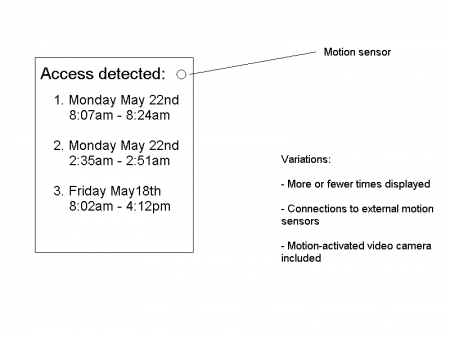There are many circumstances in which both authorized and unauthorized people wish to gain access to the same physical space. It might be a secure storage area in a shop where valuable things are kept, a secure part of a military facility storing cryptographic materials, a person’s bedroom, a bank vault, or even a child’s secret hiding place.
In all of these cases, it would be valuable for authorized users to know if someone else has been entering the controlled space.
In spaces that do not contain moving objects aside from people, it seems to me that there is a pretty simple way to provide a bit more security. All you need is a device that watches for motion and which publicly displays recent spans of time when it has been detected. It is essential that this time display be able to resist tampering by unauthorized individuals. The number of spans that should be shown depends on the level of security desired and the frequency with which the space is used.
Such a device could be useful for militaries worried about spies, businesses worried about thieving employees, and ordinary people worried about over-curious friends and relations.
Design of the device
The key components of the device are a motion sensor, a tamper-resistant display, and tamper-resistant software and hardware to run the physical devices:
Particularly for spaces that have fairly normal patterns of use, abnormal activity would be immediately obvious from the display board. For instance, the secure file storage facility of a company might ordinarily be used during business hours. The appearance of recorded activity during the middle of the night or during a weekend would attract suspicion.
This device would make a natural compliment to a motion-activated video surveillance system. Where such systems exist, people normally only watch the tapes when they have a reason to be suspicious. The tamper-resistant time display would give authorized users a reason to be wary, if unexplained access times popped up. They could then refer to the video footage for investigation. The two systems could be integrated closely. For instance, beside each of the access times displayed could be a button that causes a fast-motion version of a recorded video to be played. It would then be possible to determine at a glance what sort of activity was happening at a particular place and time. This would be especially useful for identifying false positives. After all, that mysterious movement during the middle of the night might just be the moving glare of headlights from passing cars, fluttering curtains, or something similarly benign.
Obviously, a motion-activated video system alone would be sufficient to let people identify instances of unauthorized access and sort out what happened during them. What the time display system provides is at-a-glance simplicity and ease of use. It reduces the amount of time spent worrying about false positives, and it makes it immediately clear to everyone that access to a particular space is logged. That knowledge alone could be sufficient to deter snooping and other nefarious activities.
I think it would be pretty easy to build something like this. All you need is an off-the-shelf motion sensor that you can connect to a microcontroller, a microcontroller like an Arduino, a display system (possibly a set of seven-segment displays) driven by the same board, and a source of power. A very simple system might be able to run from a solar cell and backup battery. Optional extras include physical barriers to tampering like a locked metal and plexiglass casing, tamper-evident components like seals, and systems for external logging of access times (they could be automatically emailed to a particular address, saved in a database, posted to a website, etc). As a further means of resisting tampering, the device could make use of public key cryptography to include a digital signature and time stamp for each entry in the access log.


Related: Intrusion detection systems
I just saw an ad in the Apr. 21, 2012 Economist for a product called “Avigilon” which is an HD surveillance system. Is that kind of what you had in mind?